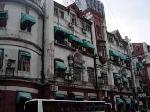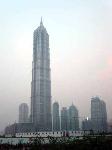- Getting around Lijiang. Dont stay in the Old Towns more than 2 days, there is nothing to do. KRISS Oct 9, 2013 05:46
- 2013 Beijing Temple Fair BENNYLAU Feb 26, 2013 03:29
- Malaysian traveling from KUL - LAX vis Shanghai PVG ZATI_DY Jan 3, 2013 20:15
Echoes of Jazz and Decadence - Part Three
- Views: 2902
- |Vote: 0 0
- |Add to Favorites
- |Recommend to Friends
The University
It was hard to get to know Shanghai my usual way – walking around and taking in the atmosphere. The city is just too big to be able to get inside so easily. My friend Steve and I were getting overwhelmed with our journey through the suburbs and looking for a way to join in.
Then, when wandering past a bus stop, we asked directions of a young woman and got into conversation. She was a sports instructor at a local gym who was also studying at a university in the North of the city - although she had a curvaceous and feminine figure, her light summer clothing revealed her to be exceptionally muscular in build. She introduced herself as Snow. We had been planning to go back to the hotel, but Snow instead invited us to take a look at her university and have a meal together at a restaurant near campus. Without better plans, we happily agreed.
The visit was a good excuse to get out of Shanghai's city centre and see the suburbs. On the bus to the university my attitude to Shanghai warmed considerably. It was the notorious history of the city that was making me feel awkward, but outside of the central streets, Shanghai revealed a different side. Shanghai is a great city, and great cities are multidimensional. In the areas where everyday Shanghainese carry out their lives, I felt that I could detect a genuine and distinct flavour that is Shanghai's own. Perhaps it is this which attracts those travellers who fall in love with Shanghai.
When we arrived at the university, I was immediately reminded of the peaceful existence I'd just a few days before left behind in Jishou, where I'd been living in a university. Somehow universities manage to invoke a comfort in the presence of scholasticism that is identical on campuses the world over. It is perhaps that they represent the best of human endeavours.
Snow called by her dormitory to pick up a friend and we four of us walked through the broad, grassy streets of the university environs, busy under the evening sky with mopeds and casually dressed students, and found a restaurant that served good local hotpot. We had a filling meal and fun conversation, and the girls decided they'd escort us back to the city so that we could all visit a nightclub together. This would involve breaking their strict curfew, but my experiences at Jishou had taught me that this was not uncommon for Chinese students nationwide.
Dancing and the Police
We eventually found ourselves on the dancefloor of one of Shanghai's trendier discos in a chic area not far from Shanghai's famous People's Park, the most well-known outdoor gathering point in the city and the site of the old British racetrack. Several DJs were poised above a brightly lit dancefloor, and the music was much less based on dance remixes of Chinese pop songs than that of other clubs I'd visited in other parts of the country. The young and irresponsible care nothing for history, and the huge, turning map of Japan projected onto the display screens in green laser light had nothing at all to do with the Japanese occupations and slaughters of 50 years before, and everything to do with young Chinese people's fascination with the country's crazy pop culture. We didn't need to buy any drinks and really enjoyed the dancing.
Later on we walked through the park to cool off in the night air, and with just the four of us we felt comfortable and at ease, and I forgot all about feeling like a foreigner. The mood didn't last: as soon as we left the park two floodlights switched on directed right at our faces, and five policemen leapt out from different directions, one seeming to descend upon us on a small motorbike as if from the sky. They questioned the girls intently, and our situation was not helped by the fact that I was the only person carrying ID. We'd of course done nothing wrong, but Steve and I, by virtue of being waiguoren in the company of young women, were under suspicion of whoring. The girls were scolded for breaking curfew and their names were taken, and once the police were satisfied that nothing was amiss, we were let be. We took a taxi back to the Pujiang, and I watched the passing lights of the city while feeling quite low in spirits. It was not so much that by virtue of my European face alone I had been assumed to be with a hooker, but rather that the behaviour of those foreigners who do quite openly employ the services of calling girls gives the impression to the Chinese that white people primarily come to Shanghai to use them. It seemed that the majority of foreigners in Shanghai live as decadently as ever before.
We put the girls into a taxi back to their university once we'd arrived at the hotel. I later found out that only Snow had been strong enough to climb herself over the locked university gates: her frailer dormmate had stayed out the whole night at a net cafe until morning, standard refuge of students waiting out their curfew until morning.
The Death Star
After spending the night at the Pujiang, we decided to make a visit to the new high-tech Economic Zone right across the river, the sub-city of Pudong. Opposing the Bund, Pudong represents the new Goliath of Shanghai's economic power, with an unmistakable skyline of that features some of the world's tallest buildings scattered out on the flat riverside territories like chesspieces. The King and Queen are the Jin Mao tower, at the time the world's third tallest building and resembling both a jagged needle of broken metal and a space ship, and the Oriental Pearl Tower, a communications mast skewering two gigantic violet glass spheres. It was 50RMB to ascend either, and we elected to go for the Jin Mao, for the simple reason that it was taller.
The most appealing way to cross the river seemed to be by ferry, and some way down the Bund we found a terminal where a boat that was more a floating concrete platform than anything else crosses the waters every ten minutes, crowded with passengers and bicycles. For a few kuai we set out on the river, floating slowly away from the Bund. Ferries that had come down the Yangtse all the way from Chongqing were drifting on the river, white layercakes of wood and metal. It had been only a fortnight since I'd made my own journey through Central China's heartland on one of them.
The contrast between Pudong and Shanghai proper could not have been more pronounced. For a start, as Pudong is a relatively new area, it seemed to be largely unpopulated. We walked from the ferry terminal to the base of the tower, passing relatively few people. The architecture of the area is astonishing, and I was reminded of the megacities shown in Science Fiction films: Pudong beneath the Jin Mao Tower seemed to be a piece right off the Death Star.
Maybe the conspicuous lack of people around revealed an underlying pretentiousness about Shanghai that also disturbed me. The spectacle of the view of Pudong from the Bund is often touted as the face of China's new economy: if those awe-inspiring towers are in fact empty of people actually doing business, then the implication for me was that the Shanghai government had invested billions in structural development way ahead of schedule for the sake of that old Chinese obsession with gaining face, this time on an international scale. What use is face when there are people starving to death in your own country? Ten years ago, the Chinese were protesting about reform coming too slowly; in retrospect, rushing things can sometimes be just as damaging.
Soon, the elevator doors opened to the viewing level at the top of the Jin Mao. I walked to the window with great interest and was rather taken aback by the view. I make a point of visiting communications towers and the like wherever possible, as the aerial view of a city often gives a humbling perspective. But in all China I had never seen such an enormous metropolis as Shanghai, and until that moment had still not conceived of just how extensive the city network is. In every direction, Shanghai was a network of twisted roadways, massive asphalt cables, a grim lattice of wealth. Looking out at Shanghai, I felt a great respect for a city that has survived countless foreign intentions to overcome Her. However, it was obvious to me, as is often said by Chinese in other parts of the country, that Shanghai is infected with a tendency to over esteem all things foreign. In Chinese, this tendency is called chong yang mei wai, and this conveys the suspicion of many Chinese that Shanghai is starting to turn its back on the rest of China. In my eyes, the blame rests on those charlatans of civility who built the city in opium and stone.






 Copyright © 1998-2025 All rights reserved.
Copyright © 1998-2025 All rights reserved.
1.
Mar 17, 2006 17:23 Reply
DONHFRASER said:
What a great view of life if China suburbia. having been up the Jin Mao Tower and travelling on the ferry I can well relate to the quiet of Pudong, a start contrast to the Nang King road etc across the river. Written with a passion and honesty you seem to have experienced the Good The bad and the Ugly of modern China.
How much longer will their be to sample the same as the rapid speed of advancement will soon leave the past behind. 10, maybe 20 years?